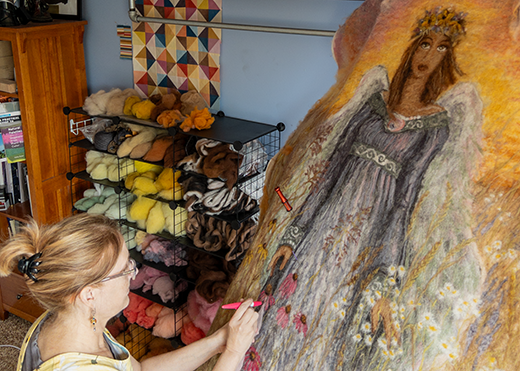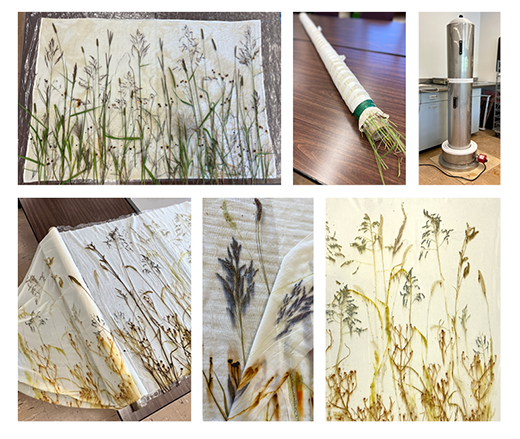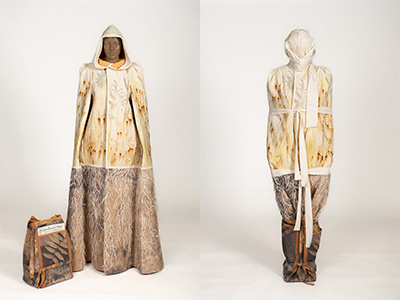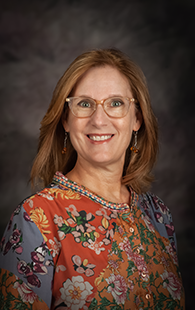Designing for death: K-State fashion professor's fiber art exhibition showcases sustainable burial practices
Wednesday, Aug. 28, 2024

Sherry Haar, professor of fashion studies in the College of Health and Human Sciences, creates textile art to promote sustainable burial practices. Her work will be on display in the upcoming "Return to Prairie: Textiles for Green Burial Awareness" exhibition at the Beach Museum of Art. Pictured above, Haar uses naturally dyed alpaca fiber to create "June Prairie Angel," a biodegradable coffin cover. | Download this photo.
MANHATTAN — When you think about fashion, you might think about Milan or the Met Gala. Perhaps you reminisce about carefully choosing outfits for special occasions or the style of your daily outfits.
Sherry Haar, a natural dye scholar and fashion studies professor at Kansas State University, has taken a different approach.
"We have clothes for everything," she said. "We have outfits for all of our significant rites of passage, so why aren't we talking about what we want to wear for our last rite of passage?
"I design for death."
Haar uses her natural dye and design expertise to create biodegradable textile art pieces — burial cloaks, quilts and coffin covers — to create conversation about sustainable end-of-life fashion and green burials, also called natural burials.
Her work will be featured in the "Return to Prairie: Textiles for Green Burial Awareness" exhibition at the Marianna Kistler Beach Museum of Art from Sept. 3-Dec. 21.
Before learning about green burials, which utilize microorganisms in the dirt to decompose the body to become soil nutrients, Haar said her practice was focused on methods to enhance plant dye to fiber bond.
"Now I am considering how fiber art can engage us in conversations about death and contribute to decomposition and environmental sustainability," Haar said.
Designing and dyeing textiles for green burials
Green burials allow for the care of the dead while preserving or restoring the burial environment. This care involves wrapping or clothing the body with biodegradable textiles.
For some of Haar's pieces, this starts with fiber from Kansas alpacas. She also uses other naturally decomposable materials like cotton, silk, hemp and wool. To give the textiles natural color, she creates and uses dyes from plants native to tallgrass prairies, including goldenrod, ironweed, sunflower and coreopsis.
"Using earth-friendly animal products and plant dyestuffs from Kansas, the textiles contribute to circularity in design when they decompose into the Earth," Haar said. "The coloration from local plants allows the dye to be returned to its soil, thus supporting a soil-to-soil system."
Using the regional plant life also gives the pieces a strong connection to the prairie setting. In addition to using the plants to create natural dyes, she also uses them to create place-based patterns and designs on the material.
Through botanical printing — where the plants are placed on pre-treated fabric and steamed, transferring the chlorophyll to the fiber to create a likeness of the plant on the piece — and plant pounding, which requires actually hammering the plants onto fabric, Haar infuses these garments with the very flora that's foundational to the beautiful Flint Hills.

These images show the botanical printing process, also called contact printing, which Haar uses to create patterns with a sense of place from local flora. Plants are placed on pre-treated fabric, rolled and steamed to transfer the chlorophyll onto the fabric, which creates an image of the plant. | Download this photo.
Prairies provide the color and place central to Haar's artistry, and she doesn't have to go far to see them. In fact, she can just look out the window of her home studio or take a few steps outside to become immersed.
"Warner Park's prairie is in my backyard," Haar said. "I get to walk this prairie and see what's in season. In addition to the Konza Prairie, this space is really my great inspiration."
She hopes to impress this relationship to place upon those who view her work.
While her textiles are functionally sound for burial, the primary aim of the fiber art is to spark interest in green burials and sustainable end-of-life practices.
Unlike the embalming and cremating practices common in the U.S., natural burials aim to conserve natural resources, reduce carbon emissions, and preserve and restore habitat through noninvasive and eco-friendly practices. According to the Green Burial Council, natural burial grounds, cemeteries, and preserves all seek to bury without impediment: no embalming, no liners or vaults, and using biodegradable containers, whether caskets, shrouds or nothing at all.
While green burial may be a new concept to many, you can find green burial ground in various cemeteries around the Sunflower State. Heart Land Prairie Cemetery, a dedicated natural burial ground on 13 acres near Niles in north-central Kansas, offers environmentally friendly, simple, affordable green burials in a beautiful prairie setting. Manhattan's own Sunrise Cemetery has a dedicated space for natural burials.
Haar wants to raise public perceptions of the practice.
"I hope my fiber art conveys a sense of curiosity about something new — in this case, of course, green burial awareness," Haar said. "I hope it spurs conversations about end-of-life plans and how human and environmental well-being can tie into those plans. I also want people to connect with the beauty, color and pattern of this special place."
"Return to Prairie: Textiles for Green Burial Awareness" opens Sept. 3 at Beach Museum of Art
Five pieces of Haar's textile art will be on display in an upcoming exhibition at K-State's Marianna Kistler Beach Museum of Art.
"Return to Prairie: Textiles for Green Burial Awareness," guest curated by Haar, will be on display from Sept. 3-Dec. 21 in the Ruth Ann Wefald Gallery.
The exhibition will include the following pieces:
• "Above & Below - Now & Later" — a statement cloak that can be worn by the living and then transitioned for burial.
• "June Prairie Angel" — a coffin cover made from alpaca fiber and inspired by walks through the prairie in June.
• "Pockets of Love" — a lap quilt for collecting loving sentiments and signatures that brings awareness to home vigils.
• "Tall Grass Prairie Burial Gown" — a burial gown inspired by Haar's Czech heritage and Ukrainian rites of passage.
• "Grandma Didn't Wear Jeans" — an upcycled denim quilt created with Kelsie Doty, assistant professor of fashion studies, as a tribute to the artists' grandmothers.

"Above & Below - Now & Later," a piece of Haar's fiber art, is a cloak that can be worn by the living, as pictured on the left, and then transitioned for burial, pictured on the right. | Download this photo.
"The Beach Museum of Art has been a longtime partner in the Prairie Studies Initiative, which explores the cultural and ecological dimensions of the prairie, challenges to sustaining grassland ecosystems, and envisioning new futures for these unique and important landscapes," said Kathrine Schlageck, the museum's associate curator of education. "The 'Return to Prairie' exhibition is a perfect example of this work."
In addition to the exhibition, the museum will host several related events throughout the fall semester, including a botanical printing workshop, a presentation about natural dye and printing, and a conversation about natural burials with the director of Heart Land Prairie Cemetery.
The Beach Museum of Art, 701 Beach Lane, is open 10 a.m. to 5 p.m. on Tuesdays, Wednesdays and Fridays; 10 a.m. to 8 p.m. on Thursdays; and 11 a.m. to 4 p.m. on Saturdays. Admission to the museum is free, and free parking is available adjacent to the building.

